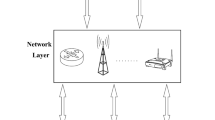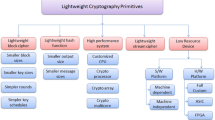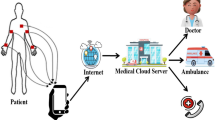Abstract
Wireless device-to-device (D2D) communication, which enables direct communication between co-located devices without Internet access, is becoming common. Simultaneously, security issues have become technical barriers to D2D communication due to its “open-air” nature and lack of centralized control. Automatically establishing the secure association between wireless devices that do not share a prior trust remains an open and challenging problem. Recent work has proposed to extract shared keys from the similar ambient radio signals of two co-located wireless devices. Using such methods, information reconciliation based on error-correcting techniques is implemented to make two co-located devices extract the same bitstreams as the shared keys from their similar ambient radio environment. However, due to the bounded capability of the error-correcting code, existing methods can only work effectively in a very short distance range. In this paper, we propose a novel solution, called proximity-based secure pairing (PSP), which allows two wireless devices in physical proximity to automatically authenticate each other and obtain shared keys according to the channel state information of the WiFi signals. In contrast to existing methods, PSP is built on private set intersection computation rather than information reconciliation, which makes it effective over a wider distance range while ensuring security and efficiency. We provide a thorough security analysis and performance evaluation of PSP and demonstrate its advantages in terms of security, efficiency and usability over state-of-the-art methods.












Similar content being viewed by others
References
Kang, H. J., Park, K. Y., Cho, K., & Kang, C. G. (2014). Mobile caching policies for device-to-device (D2D) content delivery networking. In Computer Communications Workshops (INFOCOM WKSHPS), 2014 IEEE Conference on (pp. 299–304). IEEE.
Akhtar, R., Leng, S., Wu, F., & Memon, I. (2013). Improvement of content delivery in mobile social networks. In Computational Problem-solving (ICCP), 2013 International Conference on. (pp. 139–143). IEEE.
Das, A. K., Kumari, S., Odelu, V., Li, X., Wu, F., & Huang, X. (2016). Provably secure user authentication and key agreement scheme for wireless sensor networks. Security and Communication Networks, 9(16), 3670–3687.
McCune, J. M., Perrig, A., & Reiter, M. K. (2005). Seeing-is-believing: Using camera phones for human-verifiable authentication. In 2005 IEEE Symposium on Security and Privacy (S&P’05) (pp. 110–124). IEEE.
Goodrich, M. T., Sirivianos, M., Solis, J., Tsudik, G., & Uzun, E. (2006). Loud and clear: Human-verifiable authentication based on audio. In 26th IEEE International Conference on Distributed Computing Systems (ICDCS’06) (p. 10). IEEE.
Mayrhofer, R., & Gellersen, H. (2007). Shake well before use: Authentication based on accelerometer data. In International Conference on Pervasive Computing (pp. 144–161). Springer.
Mathur, S., Miller, R., Varshavsky, A., Trappe, W., & Mandayam, N. (2011). Proximate: Proximity-based secure pairing using ambient wireless signals. In Proceedings of the 9th International Conference on Mobile Systems, Applications, and Services (pp. 211–224). ACM.
Varshavsky, A., Scannell, A., LaMarca, A., & De Lara, E. (2007). Amigo: Proximity-based authentication of mobile devices. In International Conference on Ubiquitous Computing (pp. 253–270). Springer.
Rappaport, T. S. (1996). Wireless communications: Principles and practice (Vol. 2). New Jersey: Prentice Hall PTR.
Jana, S., Premnath, S. N., Clark, M., Kasera, S. K., Patwari, N., & Krishnamurthy, S. V. (2009). On the effectiveness of secret key extraction from wireless signal strength in real environments. In Proceedings of the 15th Annual International Conference on Mobile Computing and Networking (pp. 321–332). ACM.
Premnath, S. N., Jana, S., Croft, J., Gowda, P. L., Clark, M., Kasera, S. K., et al. (2013). Secret key extraction from wireless signal strength in real environments. IEEE Transactions on Mobile Computing, 12(5), 917–930.
Liu, H., Yang, J., Wang, Y., & Chen, Y. (2012). Collaborative secret key extraction leveraging received signal strength in mobile wireless networks. In INFOCOM, 2012 Proceedings IEEE (pp. 927–935). IEEE.
Zan, B., Gruteser, M., & Hu, F. (2012). Improving robustness of key extraction from wireless channels with differential techniques. In 2012 International Conference on Computing, Networking and Communications (ICNC) (pp. 980–984). IEEE.
Liu, H., Wang, Y., Yang, J., & Chen, Y. (2013). Fast and practical secret key extraction by exploiting channel response. In INFOCOM, 2013 Proceedings IEEE (pp. 3048–3056). IEEE.
Xi, W., Li, X. Y., Qian, C., Han, J., Tang, S., Zhao, J., et al. (2014). Keep: Fast secret key extraction protocol for D2D communication. In 2014 IEEE 22nd International Symposium of Quality of Service (IWQoS) (pp. 350–359). IEEE.
Liu, Y., Draper, S. C., & Sayeed, A. M. (2012). Exploiting channel diversity in secret key generation from multipath fading randomness. IEEE Transactions on Information Forensics and Security, 7(5), 1484–1497.
Perahia, E., & Stacey, R. (2013). Next generation wireless LANS: 802.11 n and 802.11 ac. Cambridge: Cambridge University Press.
Renner, R., & Wolf, S. (2005). Simple and tight bounds for information reconciliation and privacy amplification. In International Conference on the Theory and Application of Cryptology and Information Security (pp. 199–216). Springer.
Cachin, C., & Maurer, U. M. (1997). Linking information reconciliation and privacy amplification. Journal of Cryptology, 10(2), 97–110.
Brassard, G., & Salvail, L. (1993). Secret-key reconciliation by public discussion. In Workshop on the Theory and Application of of Cryptographic Techniques (pp. 410–423). Springer.
Arain, Q., Zhongliang, D., Memon, I., et al. (2016). Privacy preserving dynamic pseudonym-based multiple mix-zones authentication protocol over road networks. Wireless Personal Communications, 95, 1–17.
Memon, I., Arain, Q. A., Memon, H., et al. (2017). Efficient user based authentication protocol for location based services discovery over road networks. Wireless Personal Communications, 95, 1–20.
Memon, I., Mohammed, M. R., Akhtar, R., et al. (2014). Design and implementation to authentication over a GSM System using certificate-less public key cryptography (CL-PKC). Wireless Personal Communications, 79, 661–686.
Memon, I., Hussain, I., Akhtar, R., et al. (2015). Enhanced privacy and authentication: An efficient and secure anonymous communication for location based service using asymmetric cryptography scheme. Wireless Personal Communications, 84, 1487C–1508.
Kamenyi, D. M., Wang, Y., Zhang, F., Memon, I., & Gustav, Y. H. (2013). Authenticated privacy preserving for continuous query in location based services. Journal of Computational Information Systems, 9(24), 9857–9864.
Gustav, Y. H., Wang, Y., Domenic, M. K., Zhang, F., & Memon, I. (2013). Velocity similarity anonymization for continuous query location based services. In Computational Problem-solving (ICCP), 2013 International Conference on (pp. 433–436). IEEE.
Memon, I., & Arain, Q. A. (2016). Dynamic path privacy protection framework for continuous query service over road networks. World Wide Web, 20(4), 639–672.
Maurer, U. M. (1993). Secret key agreement by public discussion from common information. IEEE Transactions on Information Theory, 39(3), 733–742.
Ahlswede, R., & Csiszar, I. (1998). Common randomness in information theory and cryptography. II. CR capacity. IEEE Transactions on Information Theory, 44(1), 225–240.
Sayeed, A., & Perrig, A. (2008). Secure wireless communications: Secret keys through multipath. In 2008 IEEE International Conference on Acoustics, Speech and Signal Processing (pp. 3013–3016).
Wilson, R., Tse, D., & Scholtz, R. A. (2007). Channel identification: Secret sharing using reciprocity in ultrawideband channels. IEEE Transactions on Information Forensics and Security, 2(3), 364–375.
Wang, Q., Su, H., Ren, K., & Kim, K. (2011). Fast and scalable secret key generation exploiting channel phase randomness in wireless networks. In INFOCOM, 2011 Proceedings IEEE (pp. 1422–1430).
Tope, M. A., & McEachen, J. C. (2001). Unconditionally secure communications over fading channels. In Military Communications Conference, 2001. MILCOM 2001. Communications for Network-Centric Operations: Creating the Information Force (Vol. 1, pp. 54–58). IEEE.
Mathur, S., Trappe, W., Mandayam, N., Ye, C., & Reznik, A. (2008). Radio-telepathy: Extracting a secret key from an unauthenticated wireless channel. In Proceedings of the 14th ACM International Conference on Mobile Computing and Networking (pp. 128–139). ACM.
Chou, T. H., Draper, S. C., & Sayeed, A. M. (2010). Impact of channel sparsity and correlated eavesdropping on secret key generation from multipath channel randomness. In 2010 IEEE International Symposium on Information Theory (pp. 2518–2522).
Halperin, D., Hu, W., Sheth, A., & Wetherall, D. (2011). Tool release: Gathering 802.11 n traces with channel state information. ACM SIGCOMM Computer Communication Review, 41(1), 53.
Okamoto, T., & Uchiyama, S. (1998). A new public-key cryptosystem as secure as factoring. In International Conference on the Theory and Applications of Cryptographic Techniques (pp. 308–318). Springer.
Naccache, D., & Stern, J. (1998). A new public key cryptosystem based on higher residues. In Proceedings of the 5th ACM Conference on Computer and Communications Security (pp. 59–66). ACM.
Paillier, P. (1999). Public-key cryptosystems based on composite degree residuosity classes. In International Conference on the Theory and Applications of Cryptographic Techniques (pp. 223–238). Springer.
Freedman, M. J., Nissim, K., & Pinkas, B. (2004). Efficient private matching and set intersection. In International Conference on the Theory and Applications of Cryptographic Techniques (pp. 1–19). Springer.
Li, R., & Wu, C. (2007). An unconditionally secure protocol for multi-party set intersection. In Applied Cryptography and Network Security (pp. 226–236). Springer.
GitHub Inc. (2016). A library for partially homomorphic encryption in Python. https://github.com/NICTA/python-paillier. Accessed.
Author information
Authors and Affiliations
Corresponding author
Rights and permissions
About this article
Cite this article
Cui, W., Du, C. & Chen, J. PSP: proximity-based secure pairing of mobile devices using WiFi signals. Wireless Netw 25, 733–751 (2019). https://doi.org/10.1007/s11276-017-1588-9
Published:
Issue Date:
DOI: https://doi.org/10.1007/s11276-017-1588-9




